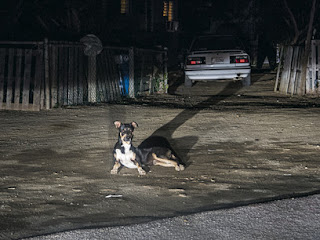{{{click on images to enlarge}}}
An overabundance of stray dogs is a clear indication that
a society is suffering in general terms. That’s why people readily believed, a
few years ago, that Detroit had about 50,000 stray dogs when this figure was erroneously
reported in a couple ‘reputable’ news sources. Other, more reliable, estimates
guessed at 1,000 to 3,000 stray dogs in Detroit. People falsely bought into the
claim of 50,000 stray dogs because they believed that life in Detroit is tough:
the tougher life is in a city, the more stray dogs you’ll have. Of course we also
know that one way Vladimir Putin went about showing the world that Sochi was a
wonderful, developed place was to shoot and poison the massive numbers of stray
dogs before any Olympic tourists arrived.
Who needs to solve underlying problems of poverty when you can use the
state apparatus to just kill the dogs and hope other dogs don’t show up until
after the closing ceremonies?
When Spanish photographer Yapci Ramos arrived in Aruba,
she noticed a lot of stray dogs. The notes from the show at Catinca Tabacaru
Gallery on Manhattan’s Lower East Side quote her: “Aruba is a small island full
of stray feral ‘perras’ (bitches) surviving as best they can; languorous
bitches, fierce bitches, vulnerable bitches, flea-ridden bitches, quiet
bitches, aggressive bitches…bitches.” Ramos presents photos of prostitutes she
has met in the Canary Islands and the Republic of Congo in her current show,
along with these stray dogs from Aruba. So although the show is called “Perras
y Putas” and could, possibly, be translated as Bitches (female dogs) and
Bitches (prostitutes/whores), it seems clear to me that the dogs represent or
evince a pervading social and governmental apathy in the types of societies
where many sex workers are compelled to make their living.
The presence of the dogs indicates that the women in
these photos are not a part of the state-regulated prostitution of ‘developed’
European nations, which makes the profession more palatable to its well-heeled,
power-wielding inhabitants. This is not the prostitution of feminist
empowerment in this show, but prostitution as a survival mechanism with adverse
consequences to the sex worker which are hard if not impossible to capture
through the medium of photography.
To me Ramos deliberately, perhaps, reveals a significant limitation
of photography and, by combining the photos of the dogs and the women, the show
seems to acknowledge this limitation and searches for ways to compensate for
it. To what extent can the photographer really capture the process of life that
these women are going through? By including the dogs as examples of a society’s
overall poverty, ignorance and callousness, she ingeniously sheds some light on
why these women are doing what they are doing and how they may be affected by
being what the show’s notes call private individuals with “public bodies”.
One of the more famous photographers of prostitutes was,
of course, E.J. Bellocq, whose work from about 100 years ago in New Orleans was
discovered and promoted by Lee Friedlander in the 60s and 70s. Bellocq, who may
have been physically deformed and is therefore sometimes compared to Toulouse
Lautrec, seemed to enjoy hanging around the various brothels in town and took
photos of the prostitutes he apparently idolized, revealing aspects of
individual character in settings that revealed relative comfort. The
prostitutes seem content and jovial in Bellocq’s work. Ramos seems to present
her prostitutes in the type of tradition that can probably be traced back to
Bellocq; we do not see them suffering and some even seem content and happy. In some of the Congo photos, the women seem to
revel in their situations.
The photos therefore beg various questions: If these
women seem to be OK, why should this be my business? Unlike powerless dogs,
these are human beings with the capacity for choice and agency – should I
really care about them? Yet, one can ask whether they truly made any
significant choices or whether they were subtly and inevitably coerced through
the structure and functions of their societies into situations where they had
to spread their legs on a daily basis to make a buck or two to survive. Just
because they are happy doesn’t mean this is right or that they are being given
the best possible choices for their lives in their given societies. We often
make the best of rotten situations.
The key to absorbing what these photos offer is that
these women are not living in abject poverty, yet, can we say that their lives
are meaningful or that they would even keep these lives if other opportunities
arose? Just how do we or should we engage these women staring at us from these
photos, flanked by hungry, desperate, frightened dogs? To a great extent, these
women may be proxies for many of us – living lives of relative comfort while
doing something we abhore, wondering whether there might be something so much
better for us.
This powerful and affecting show runs at Catinca Tabacaru
Gallery until October 11, 2015. If you are trekking through the Lower East Side
galleries any time soon, this gallery, which regularly presents amazing work,
would be well worth your time.


































